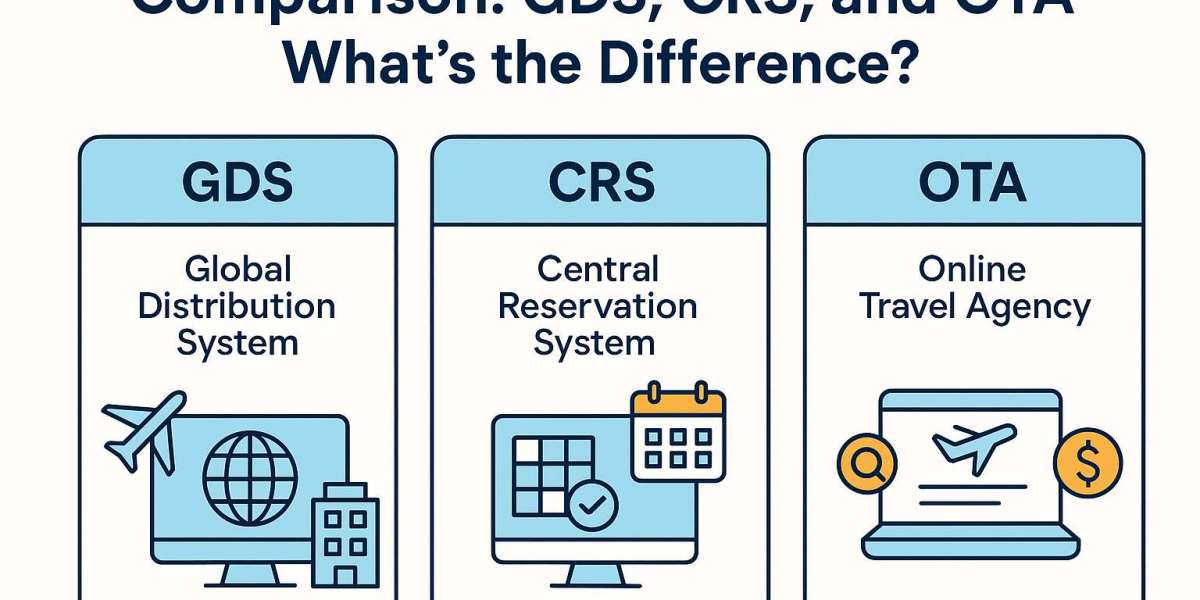The travel industry runs on technology that connects travelers with hotels, airlines, and other service providers.
Three key systems make this happen: GDS (Global Distribution System), CRS (Central Reservation System), and OTA (Online Travel Agency). Each plays a unique role, and knowing how they differ — and work together — is essential for travel agencies, hotels, airlines, and anyone involved in booking travel.
What is a GDS?
A Global Distribution System (GDS) is a massive computer network that lets travel agencies book flights, hotels, car rentals, and more from suppliers all over the world. Think of it as a powerful middleman that brings together thousands of airlines, hotels, and travel agents so they can do business quickly and efficiently.
Key features of a GDS include:
Global Reach: It connects travel agencies with hundreds of airlines, hotels, and car rental companies worldwide.
Real-Time Updates: Availability, pricing, and booking status are updated instantly so agents always have the latest information.
Multiple Options: Travel agencies can use more than one GDS (like Amadeus, Sabre, or Galileo) to give customers more choices.
Automation: Fare calculations, ticketing, and itineraries happen automatically.
Data & Analytics: GDS platforms offer reporting tools that help agencies track sales and performance.
What is a CRS?
A Central Reservation System (CRS) is software that hotels, airlines, and other suppliers use to manage their own reservations. It helps them keep track of inventory, set prices, handle bookings, and share their availability with partners like GDS and OTAs.
Key functions of a CRS include:
Centralized Management: It keeps a real-time record of rooms or seats available across multiple channels.
Rate Control: Hotels and airlines can set prices, discounts, and packages.
Reservation Handling: CRS systems process bookings, confirmations, changes, and cancellations.
System Integration: They connect with property management systems (PMS) in hotels and with GDS networks for seamless updates.
Customer Profiles: CRSs store guest information, preferences, and loyalty details.
What is an OTA?
An Online Travel Agency (OTA) is what most travelers are familiar with — websites or apps like Expedia or Booking.com where people can search, compare, and book travel services directly. Unlike GDS or CRS, which are built for businesses, OTAs are designed for end-users: the travelers themselves.
Main features of OTAs include:
Easy-to-Use Interfaces: OTAs have search tools, filters, and booking forms that make it simple for travelers to find what they need.
Price Comparisons: They help customers compare prices, amenities, and reviews from multiple providers.
Bundled Deals: Many OTAs let travelers book flights, hotels, car rentals, and activities together.
Marketing Power: OTAs spend heavily on online advertising and promotions to attract customers.
Customer Support: They handle payments, refunds, and traveler inquiries directly.
Key Differences Between GDS, CRS, and OTA
Here’s how they compare in a nutshell:
Purpose:
GDS: Acts as a global booking network connecting suppliers with travel agents.
CRS: Helps suppliers manage and distribute their own inventory.
OTA: Sells travel services directly to travelers online.
Users:
GDS: Travel agencies, tour operators, corporate travel managers.
CRS: Hotels, airlines, and their reservation teams.
OTA: End-users — people booking travel for leisure or business.
Technology:
GDS: Connects multiple suppliers and agencies through standardized protocols.
CRS: Integrates with a supplier’s own systems and external channels.
OTA: Uses web technologies and APIs to pull inventory from CRS and GDS, then display it to travelers.
How They Make Money:
GDS: Charges fees to travel agencies and suppliers for each booking.
CRS: Operates on a subscription or licensing model paid by the supplier.
OTA: Earns commissions (usually 10–25%) on bookings or charges listing fees.
Conclusion
In summary, while GDS, CRS, and OTAs are all essential to the travel industry, each serves a distinct purpose and audience. GDS platforms, or Global Distribution Systems in travel, act as powerful intermediaries connecting travel agencies to a vast network of airlines, hotels, and car rental companies, enabling global reach and efficient bookings through some of the top GDS systems like Amadeus, Sabre, and Galileo. CRS systems provide key Central Reservation System benefits by helping suppliers like hotels and airlines manage their inventory, rates, and reservations centrally, ensuring accurate distribution across multiple channels.







